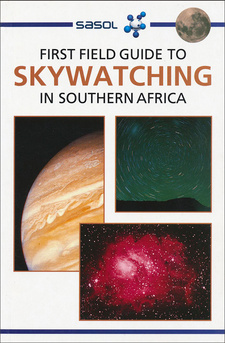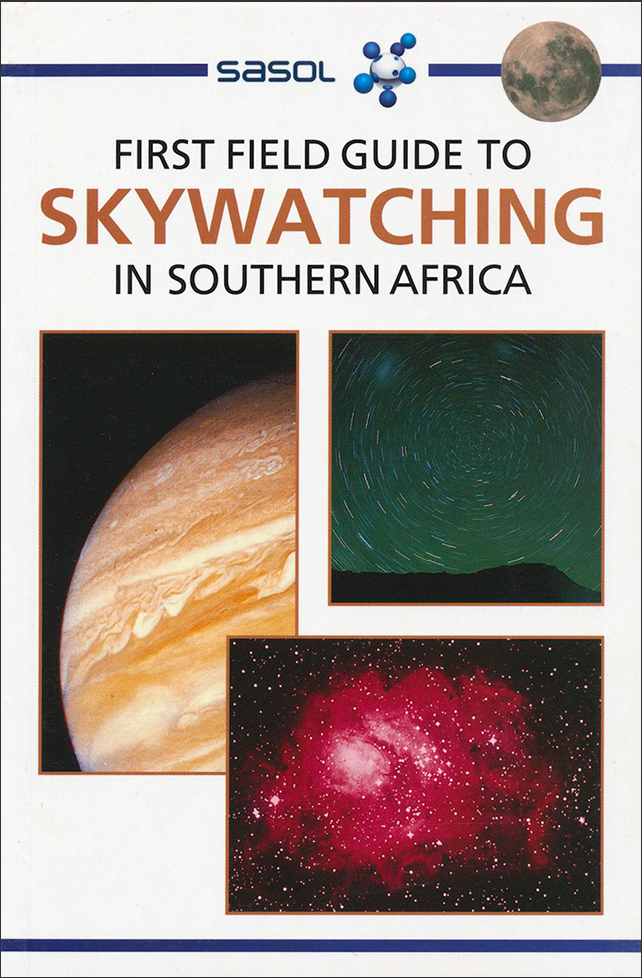First Field Guide to Skywatching of Southern Africa, by Cliff Turk

First Field Guide to Skywatching of Southern Africa, by Cliff Turk. Publisher: Penguin Random House South Africa (Pty) Ltd. Imprint: Struik Nature. 2nd edition. Cape Town, South Africa 2015. ISBN 9781775843894 / ISBN 978-1-77584-389-4
Cliff Turk, author of First Field Guide to Skywatching of Southern Africa, is a Fellow of the Royal Astronomical Society and a member of the Astronomical Society of Southern Africa.
Practical stargazing
The best way to familiarise yourself with the night sky is to step outside and look above you, on a regular basis. You will see many objects, some twinkling, some apparently static; occasionally there is something moving steadily across the sky and sometimes things even appear as whizzing and fading streaks of light. And of course there is the Moon. By far the most numerous of all the objects are stars, and it may at first seem a daunting task to begin to identify and recognise specific stars and constellations0. The secret is to start slowly, with the aim of learning to recognise no more than two or three objects in the sky each night. To start with, it is best to use just the naked eye, as optical aids increase the number of stars and other objects so dramatically that it is easy to get lost. You will eventually want to see some of the objects beyond the ability of the naked eye, and then the best option is binoculars (see page 9). Star charts or maps are essential aids to finding and identifying stars. These charts plot the stars and constellations against a contrasting background, and show the night skies at a given time of the year. A set of star charts, one for each month of the year, appears on pp. 42-53. Before using the charts outside, spend some time indoors studying them. Use a soft pencil to identify shapes to look for when outside. A 2B pencil, used lightly, can be erased easily, leaving the charts still usable. To use a star chart, it is necessary to orientate yourself with the main compass points. This is best achieved with a simple compass, remembering that it will point to magnetic north (or south), which are about 20° to 25° to the left of the true directions. This magnetic variation changes with your location and from year to year. Your eyes take some 20 minutes or longer to become fully accustomed to the dark. Torch light (needed to read the charts) can hinder this process and it is better to use a red-light torch, which will not interfere with dark adaptation. Red cellophane or a piece of red plastic, cut to size and fitted in place of the torch's clear glass disk, works well. The relative positions of the stars are for all practical purposes fixed at a given time, and if an astronomer from 2,000 years ago were to see the sky tonight, he would recognise all his favourite constellations0. Individual movement of the stars is negligible, but the movement of the whole night sky further to the west from one night to the next is due to the Earth's orbit around the Sun. The planets (see page 29), however, do move against the starry background, all at different speeds. The Moon also moves independently of the background. For this reason, the Moon and planets are not plotted in star atlases. If you want to locate the planets it is worthwhile getting an annual handbook (see 'Further reading', page 55), which contains a diary of events showing when the Moon is north or south of the brighter stars and planets, as it moves across the sky. [...]
This is an excerpt from First Field Guide to Skywatching of Southern Africa, by Cliff Turk.
Title: First Field Guide to Skywatching of Southern Africa
Author: Cliff Turk
Struik Publishers
Genre: Astronomical Guide
Publisher: Penguin Random House South Africa (Pty) Ltd.
Imprint: Struik Nature
2nd edition. Cape Town, South Africa 2015
ISBN 9781775843894 / ISBN 978-1-77584-389-4
Paperback, 11 x 17 cm, 56 pages, throughout colour photos
Turk, Cliff im Namibiana-Buchangebot
First Field Guide to Skywatching of Southern Africa
First Field Guide to Skywatching in Southern Africa is a fascinating insight into the southern skies by night.

